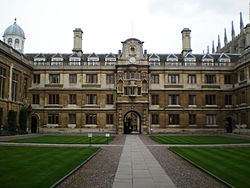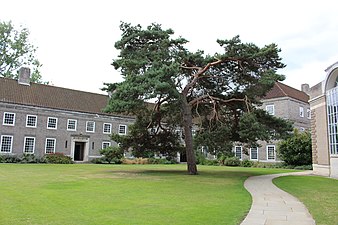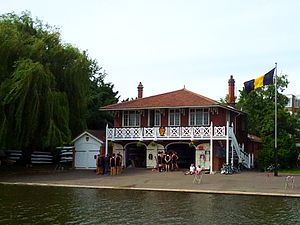Difference between revisions of "Clare College, Cambridge"
(Created page with "{{distinguish|Clare Hall, Cambridge}} {{Infobox college |name=Clare College |county=Cambridgeshire |university=Cambridge |picture=Clare college.jpg |picture caption=Entrance t...") |
(No difference)
|
Latest revision as of 21:31, 28 March 2024
- Not to be confused with Clare Hall, Cambridge
| Clare College
| |||||||||||
 Entrance to Clare College | |||||||||||
|---|---|---|---|---|---|---|---|---|---|---|---|
| Master: | Loretta Minghella | ||||||||||
| Website: | clare.cam.ac.uk | ||||||||||
| |||||||||||
| Location | |||||||||||
| Grid reference: | TL44625844 | ||||||||||
| Location: | 52°12’19"N, 0°6’54"E | ||||||||||
Clare College is a constituent college of the University of Cambridge[1] in Cambridge, Cambridgeshire. The college was founded in 1326 as University Hall, making it the second-oldest surviving college of the University after Peterhouse. It was refounded in 1338 as Clare Hall by an endowment from Elizabeth de Clare, and took on its current name in 1856. Clare is famous for its chapel choir and for its gardens on "The Backs" (the back of the colleges that overlook the River Cam).
Contents
History
The college was founded in 1326 by the university's Chancellor, Richard Badew, and was originally named University Hall. Providing maintenance for only two fellows, it soon hit financial hardship. In 1338, the college was refounded as Clare Hall by an endowment from Elizabeth de Clare, a granddaughter of Edward I, which provided for twenty fellows and ten students.[2]
The college was known as Clare Hall until 1856, when it changed its name to "Clare College".[3] (A new "Clare Hall" was founded by Clare College as an exclusively postgraduate institution in 1966.)
Women were accepted as undergraduates in 1972, one of the first three previously all-male colleges to do so.[4]
Buildings
Old Court
Clare's Old Court, a Grade I listed building, frames King's College Chapel. It was built between 1638 and 1715,[3] with a long interruption for the Civil War. The period spans the arrival of classicism into the mainstream of British architecture, such that its progress can be traced in the marked differences between the oldest wing to the north, which still has vaulting and other features in the unbroken tradition of Gothic, and the final southern block, which shows a fully articulated classic style.
The college's chapel was built in 1763 and designed by Sir James Burrough, the Master of neighbouring Caius College.[5]
Clare Bridge
Clare has a bridge over the River Cam, which is the oldest of Cambridge's current bridges. It was built of stone in 1640 by Thomas Grumbold and restored in 1969, and is a Grade I listed building.[6]
Fourteen stone balls decorate it, one of which has a missing section. A number of apocryphal stories circulate concerning this – the one cited by members of the college is that the original builder of the bridge was not paid the full amount for his work and so removed the segment to balance the difference in payment. A more likely explanation is that a wedge of stone cemented into the ball as part of a repair job became loose and fell out.
Memorial Court
Clare's bridge connects Old Court to Memorial Court, which was designed by Giles Gilbert Scott and dedicated in 1926. Memorial Court was extended in the 1950s by the construction of Thirkill Court, and was later divided into two parts when the College's Forbes Mellon Library was constructed in the centre of Memorial Court; the new courtyard created in the west was renamed Ashby Court.[7]
Lerner Court
A new court, Lerner Court, designed by the architects van Heyningen and Haward, was opened in January 2008. It occupies the last piece of undeveloped land in the central area of the College next to Memorial Court and houses a lecture theatre, catering, fellows offices, residential accommodation and a student laundry.
Gallery
Outside links
| ("Wikimedia Commons" has material about Clare College, Cambridge) |
References
- ↑ Walker, Timea (2022-01-19). "Clare College" (in en). https://www.undergraduate.study.cam.ac.uk/colleges/clare-college.
- ↑ A History of the County of Cambridgeshire - Volume 3 pp 340-346: The colleges and halls: Clare College (Victoria County History)
- ↑ 3.0 3.1 Tim Rawle (1993). Cambridge Architecture (2nd ed.). André Deutsch. p. 100. ISBN 0-233-98818-1.
- ↑ "Five decades after Cambridge colleges went co-ed, too little has changed". Financial Times. 2022-08-31. https://www.ft.com/content/db52b02b-088f-4bfc-8e66-ce7dda0267fc.
- ↑ Dictionary of National Biography, Vol 07 pp 444-445: Burrough, James (1691-1764)
- ↑ National Heritage List 1125549: Clare College, Clare Bridge (Grade I listing)
- ↑ Clare College Cambridge. "Memorial Court - Clare College Cambridge". http://www.clare.cam.ac.uk/Memorial-Court/.
| Colleges of the University of Cambridge | |
|---|---|
|
Christ’s • Churchill • Clare • Clare Hall • Corpus Christi • Darwin • Downing • Emmanuel • Fitzwilliam • Girton • Gonville and Caius • Homerton • Hughes Hall • Jesus • King’s • Lucy Cavendish • Magdalene • Murray Edwards • Newnham • Pembroke • Peterhouse • Queens’ • Robinson • St Catharine’s • St Edmund’s • St John’s • Selwyn • Sidney Sussex • Trinity • Trinity Hall • Wolfson |
|













